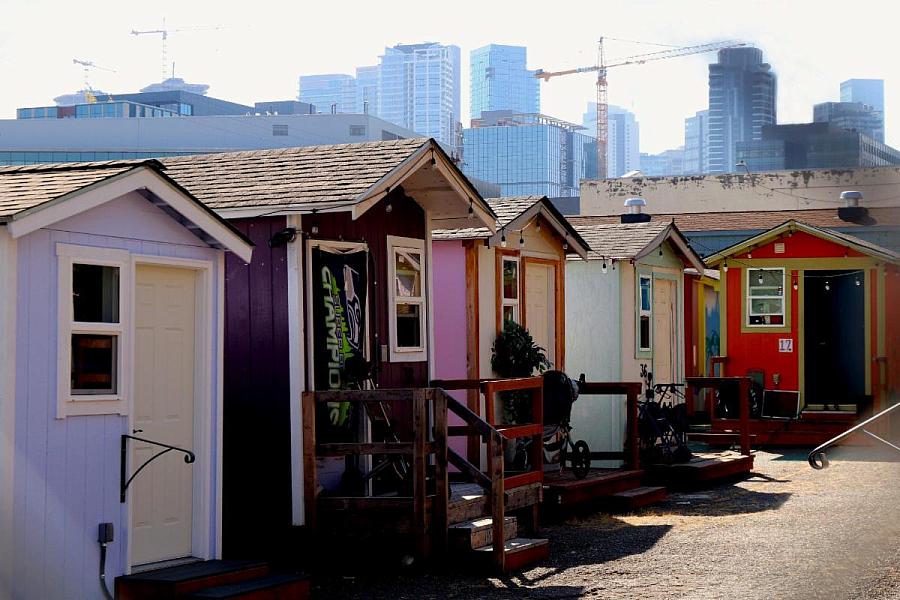The Health Divide: Can tiny homes help address the housing needs of the transgender community?

(Photo via Flickr/Creative Commons)
The last time the U.S. Department of Housing and Urban Development measured homelessness, it counted 653,104 unhoused Americans in its 2023 annual point-in-time report. That’s a 12% increase from the same report in 2022.
While the share of transgender individuals experiencing homelessness is 1.2%, the total number has increased 88% since 2016 — about one in five are unhoused at any given point in time.
Research has found that transgender individuals often encounter barriers when attempting to access shelter due to their gender identities. This is compounded by the fact that they are more likely to experience hate crimes and violence.
Some cities in the United States have implemented tiny homes as a solution to the transgender housing crisis. These homes, typically no larger than 400 square feet, can provide a vital resource for those without stable housing. Securing employment or accessing public services can be challenging without an address, making tiny homes a crucial lifeline for those in need.
Tiny homes open up job opportunities
In Memphis, Tennessee, a nonprofit is addressing the transgender homelessness problem one tiny home at a time.
Every Thursday, Kayla Gore, a transgender woman, gives out care kits to those who identify as LGBTQI+. Gore, who was unhoused more than a decade ago, knows how hard it is for members of the trans community to find housing.
When she was homeless, she said members of the trans community showed her how to be safe on the streets. They showed her where to sleep, where she could go eat, and how to protect herself from being harmed by people who were out to hurt her just because she was Black and trans.
Gore now works for the trans-led nonprofit My Sistah’s House, which she co-founded in 2016 with Illyahnna Watts in Memphis, providing emergency housing and services to transgender people in need.
“A lot of people don’t understand the experiences of trans people,” Gore told CBS News.
Many transgender individuals are unable to get jobs that pay a living wage. This makes it difficult for them to save money for necessities like housing, food, clothing, and transportation.
Tennessee's at-will employment policy means employers can terminate an employment relationship without providing a reason or notice. This policy disproportionately impacts the LGBTQI+ community, especially transgender individuals who are more likely to face discrimination at work and consequently lose their jobs, Gore said.
One of the biggest obstacles the trans community faces when it comes to achieving public or government assistance stems from not having an address, said Gore.
When you don’t have an address to put on a job application, it raises red flags with a potential employer.
Employers typically don’t offer jobs to the homeless, yet stable employment is needed to earn money to obtain housing.
“It makes no sense,” Gore said.
If you think it’s tough to find housing as a trans person, it’s even more complicated if you are African American and trans. More than half of Black trans women have been homeless.
When COVID-19 hit, the demand for housing spiked, and that’s when Gore decided to act.
In 2022, Gore secured $600,000 to purchase lots and build 20 tiny homes in Memphis for homeless trans women to own. Two homes have been built to date, and as more are built, the group is adding supportive services to help those who move in.
But the needs are large: 20% of Black transgender women had been kicked out of a house because of their gender identity, and 49% of Black transgender women reported having experienced some form of housing discrimination in the previous year, trans advocates say.

A tiny home developed by My Sistah’s House in Memphis.
Photo via My Sistah’s House
Tiny homes are gaining steam for addressing homelessness
The tiny homes project is not new for those with housing needs. For example, a tiny home veterans housing project in Milwaukee is planned for the northwest side. The $11.7 million plan will have 24 tiny homes and a community center for homeless vets.
Groundbreaking for the tiny homes project is expected to begin this summer. The homes will range from 240 to 360 square feet. The goal is to help veterans stay stable and find work.
Other places are also using the tiny home method to address homelessness.
In Denver, there is a tiny home village for women, LGBTQ, and nonbinary people. On any given night, one-third of the 4,000 people experiencing homelessness in Denver are women or transgender individuals.
In 2023, in Tucson, Arizona, a project was planned to build two tiny homes as temporary housing for transgender women of color. The tiny homes will serve as transitional housing free of cost for transgender women while they find permanent housing.
In Atlanta, the Trans Housing Coalition helps homeless trans people with emergency hotel stays, and they work with landlords to minimize discrimination on behalf of their clients.
Tiny homes are not a panacea for homelessness. They can be surprisingly expensive to build, given their size, and they don’t always serve as a stepping stone to permanent housing or keep people from returning to homelessness, as reporting has shown.
But tiny homes do offer protection for some of the nation’s most vulnerable populations and some form of stability. A tiny house is more than a place to lay their head.
A tiny home comes up large because it gives a person a place for restful sleep and a door they can lock at night for protection. It also offers them a place to work on themselves without the fear of being attacked or harassed.
It’s also a place that they can call home.

